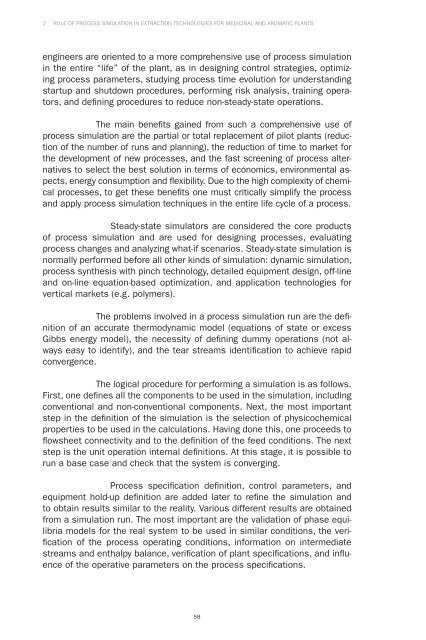Extraction Technologies For Medicinal And Aromatic Plants - Unido
Extraction Technologies For Medicinal And Aromatic Plants - Unido
Extraction Technologies For Medicinal And Aromatic Plants - Unido
Create successful ePaper yourself
Turn your PDF publications into a flip-book with our unique Google optimized e-Paper software.
2 ROLE OF PROCESS SIMULATION IN EXTRACTION TECHNOLOGIES FOR MEDICINAL AND AROMATIC PLANTS<br />
engineers are oriented to a more comprehensive use of process simulation<br />
in the entire “life” of the plant, as in designing control strategies, optimizing<br />
process parameters, studying process time evolution for understanding<br />
startup and shutdown procedures, performing risk analysis, training operators,<br />
and defi ning procedures to reduce non-steady-state operations.<br />
The main benefi ts gained from such a comprehensive use of<br />
process simulation are the partial or total replacement of pilot plants (reduction<br />
of the number of runs and planning), the reduction of time to market for<br />
the development of new processes, and the fast screening of process alternatives<br />
to select the best solution in terms of economics, environmental aspects,<br />
energy consumption and fl exibility. Due to the high complexity of chemical<br />
processes, to get these benefi ts one must critically simplify the process<br />
and apply process simulation techniques in the entire life cycle of a process.<br />
Steady-state simulators are considered the core products<br />
of process simulation and are used for designing processes, evaluating<br />
process changes and analyzing what-if scenarios. Steady-state simulation is<br />
normally performed before all other kinds of simulation: dynamic simulation,<br />
process synthesis with pinch technology, detailed equipment design, off-line<br />
and on-line equation-based optimization, and application technologies for<br />
vertical markets (e.g. polymers).<br />
The problems involved in a process simulation run are the defi -<br />
nition of an accurate thermodynamic model (equations of state or excess<br />
Gibbs energy model), the necessity of defi ning dummy operations (not always<br />
easy to identify), and the tear streams identifi cation to achieve rapid<br />
convergence.<br />
The logical procedure for performing a simulation is as follows.<br />
First, one defi nes all the components to be used in the simulation, including<br />
conventional and non-conventional components. Next, the most important<br />
step in the defi nition of the simulation is the selection of physicochemical<br />
properties to be used in the calculations. Having done this, one proceeds to<br />
fl owsheet connectivity and to the defi nition of the feed conditions. The next<br />
step is the unit operation internal defi nitions. At this stage, it is possible to<br />
run a base case and check that the system is converging.<br />
Process specifi cation defi nition, control parameters, and<br />
equipment hold-up defi nition are added later to refi ne the simulation and<br />
to obtain results similar to the reality. Various different results are obtained<br />
from a simulation run. The most important are the validation of phase equilibria<br />
models for the real system to be used in similar conditions, the verifi<br />
cation of the process operating conditions, information on intermediate<br />
streams and enthalpy balance, verifi cation of plant specifi cations, and infl uence<br />
of the operative parameters on the process specifi cations.<br />
58

















